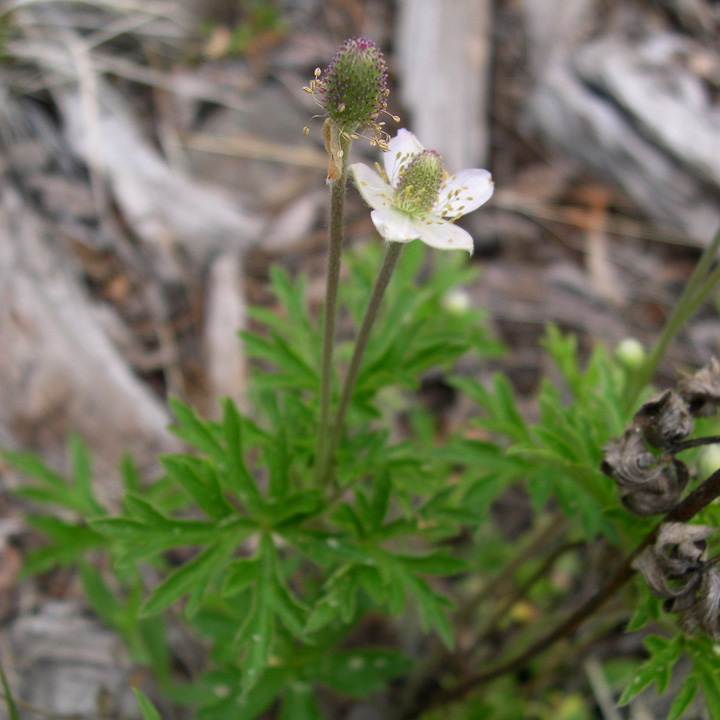
|
Family: Ranunculaceae |
Herbs , perennial, from rhizomes, caudices, or tubers. Leaves basal, simple or compound, petiolate. Leaf blade lobed or parted or undivided, reniform to obtriangular or lanceolate, margins entire or variously toothed. Inflorescences terminal, 2-9-flowered cymes or umbels, or flowers solitary, to 60 cm; involucres present, often with primary involucres subtending inflorescences, and secondary and tertiary involucres subtending inflorescence branches or single flowers (primary, secondary, and tertiary involucres appearing to be in tiers), involucral bracts 2-7(-9), leaflike or sepaloid, distant from or close to flowers. Flowers bisexual, radially symmetric; sepals not persistent in fruit, 4-20(-27), white, purple, blue, green, yellow, pink, or red, plane, linear to oblong or ovate to obovate, 3.5-40 mm; petals usually absent (present in A . patens ), distinct, plane, obovate to elliptic, 1.5-2 mm; nectary present; stamens 10-200; filaments filiform or somewhat broadened at base; staminodes absent between stamens and pistils; pistils many, simple; ovule 1 per pistil; style present. Fruits achenes, aggregate, sessile or stalked, ovoid to obovoid, sides not veined; beak (persistent style) present, sometimes rudimentary, terminal, straight or curved, to 40(-50) mm, sometimes plumose. x =7 or 8. The taxonomy of Anemone continues to be problematic. Anemone occidentalis and A . patens var. multifida (the first two taxa in this treatment) are frequently placed in the genus Pulsatilla Miller on the basis of the long plumose achene beaks, and A . acutiloba and A . americana (the last two taxa in this treatment) in the genus Hepatica Miller, primarily on the basis of the involucre immediately subtending the flower and the lobed, persistent leaves. Recent phylogenetic analyses of Anemone in the broad sense, however, indicate that both Pulsatilla and Hepatica should be subsumed within Anemone . While traditional morphologic characters are useful in distinguishing between Pulsatilla and Hepatica species, respectively, many other morphologic and molecular attributes are shared with Anemone , strongly suggesting that these genera should be united (S. B. Hoot et al. 1994). In addition, a number of genera that have been recognized primarily on a cytotaxonomic basis (e.g., Anemonastrum , Anemonidium , Anemonoides , and Jurtsevia ) are reduced to synonymy here. Some North American species of Anemone are closely related to plants in Europe, Asia, and South America and continue to be recognized at different ranks. For example, Anemone patens Linnaeus var. multifida (a species included in this treatment) was called Pulsatilla multifida (Pritzel) Juzepczuk for the former Soviet Union by S. V. Juzepczuk (1970) and Pulsatilla patens (Linnaeus) Miller var. multifida (Pritzel) Li S.H. & Huang Y. H. for China by Wang W.-T. (1980). Moreover, interspecific hybridization among some sympatric or nearly sympatric North American species also contributes to the confusion (see N. L. Britton 1891; C. L. Hitchcock et al. 1955-1969, vol. 2; R. S. Mitchell and J. K. Dean 1982). Additional analyses (e.g., G. Boraiah and M. Heimburger 1964; M. Heimburger 1959; C. Joseph and M. Heimburger 1966; and C. S. Keener et al. 1995) may prove to be helpful in resolving the taxonomy within this morphologically diverse genus. Sep 4-20, petaloid; pet none; pistils numerous, in a subglobose to cylindric head, pubescent; style short or elongate; stigma minute; achenes flattened, clavate, or fusiform, tipped with the persistent style; perennials from a rhizome or caudex, with palmately deeply divided basal lvs and an erect stem with a whorl of 3 or more involucral lvs subtending one or more elongate peduncles; fls medium-sized to large, white to blue or red or greenish. (Pulsatilla) 100+, N. Hemisphere. Gleason, Henry A. & Cronquist, Arthur J. 1991. Manual of vascular plants of northeastern United States and adjacent Canada. lxxv + 910 pp. ©The New York Botanical Garden. All rights reserved. Used by permission. |
This project was made possible in part by the Institute of Museum and Library Services [MG-70-19-0057-19].
Powered by Symbiota



